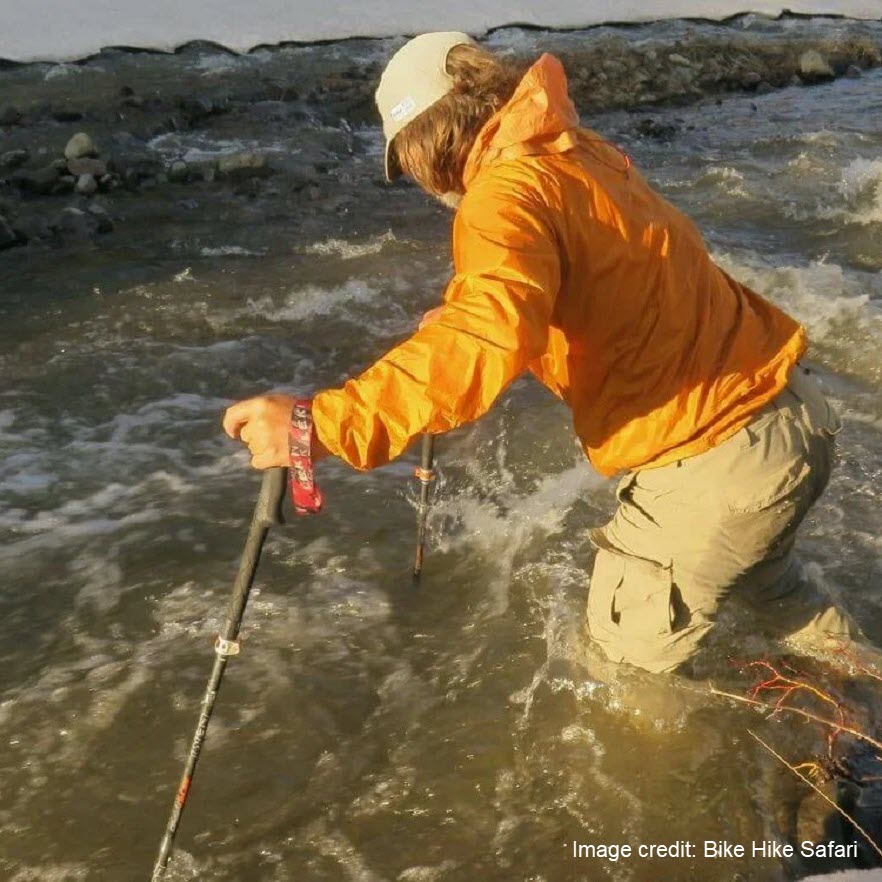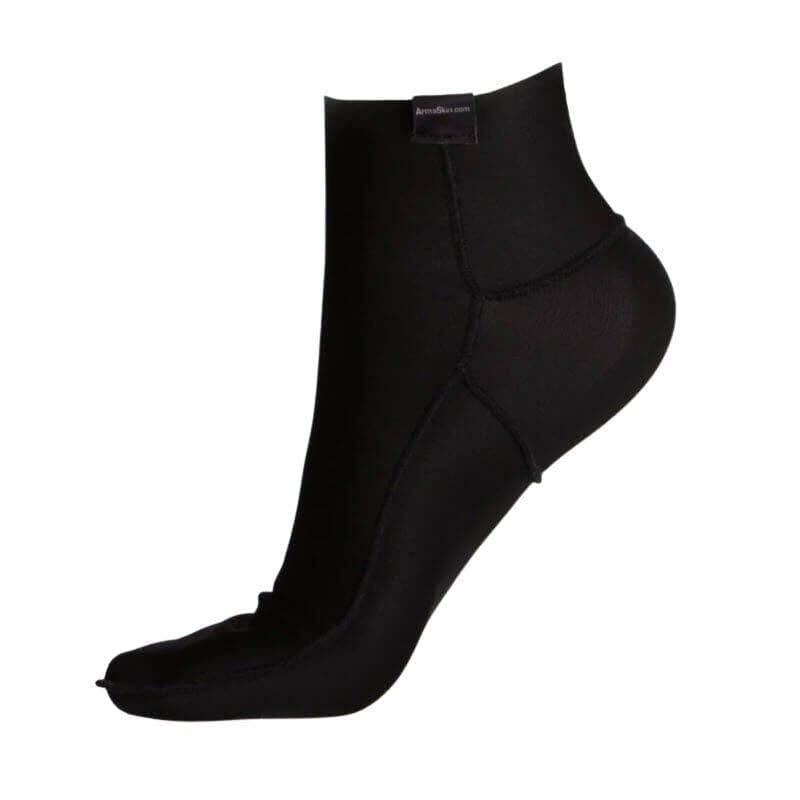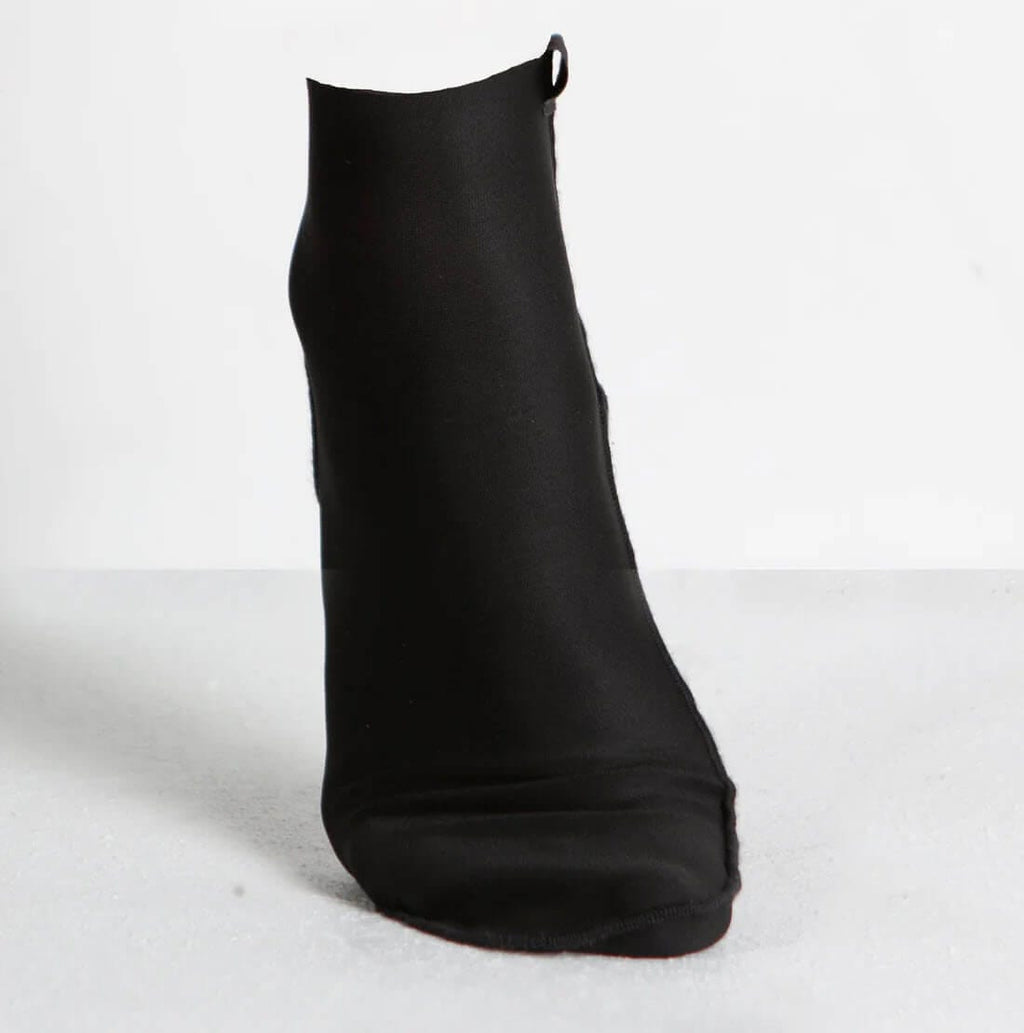When hiking for days at a time, or running in multiday events, maceration is to be avoided at all costs. Macerated skin is severely weakened due to waterlogging. It is so weakened that it is unable to sustain the shear loads applied to the skin during locomotion. Instead of stretching back and forth, it tears, and large sheets of skin can be left hanging from the feet. Waterproof socks are one of the potential preventions, and that’s what we’ll be looking at in this article. Visit these links for more information on the maceration prevention and maceration treatment. TL;DR: prevention is EVERYTHING because there is no treatment other than giving the skin time to dry out (and that takes at least several days).
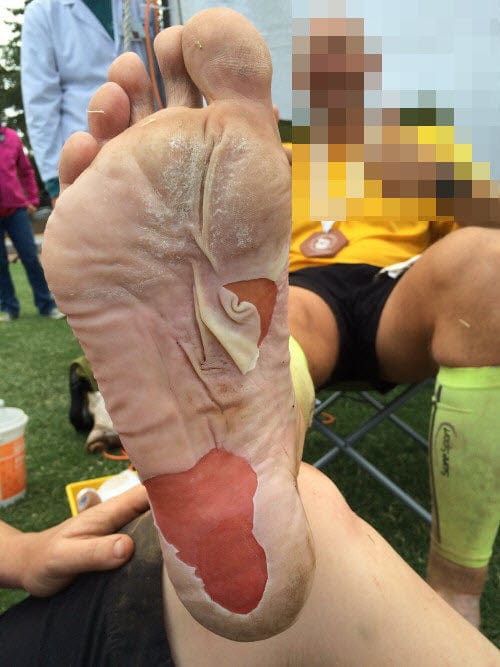
Sheets of macerated skin peeling off (source: https://www.fixingyourfeet.com/)
What Causes Maceration
Any source of water or moisture can macerate the skin. Here are three examples that I commonly see, as a podiatrist who specialises in blister management in ultradistance athletic events:1) Blister Fluid (internal source)
Localised maceration can occur when blisters burst. The sock and/or the dressing in place becomes waterlogged, which in turn waterlogs the skin. Again, the whole sheet of skin affected can tear away. The easiest fix is to change into dry socks, replace island blister dressings more frequently, and implement a great prevention for that blister location to stop the damaging forces making the blister continually weep.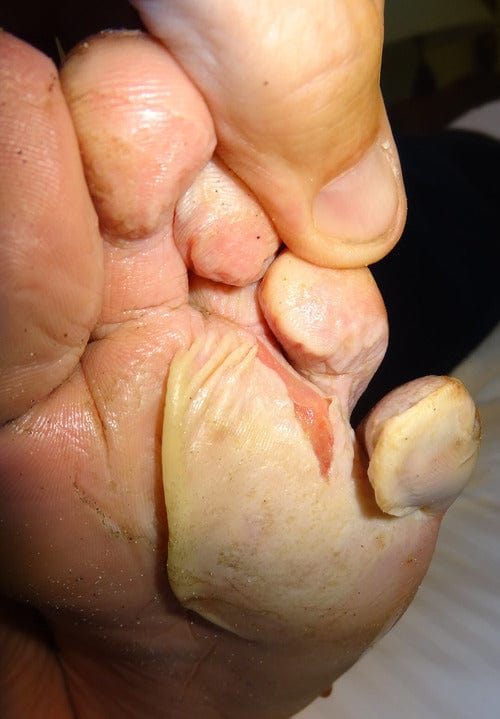
Torn macerated skin caused by a burst blister that saturated the nearby sock. Notice the macerated 5th toe skin too.
2) Excessive Perspiration (internal source)
Maceration can also occur with excessive sweating. This may be due to a condition called hyperhidrosis, or simply due to the duration and level of exertion in hot humid environmental conditions. Maceration will occur more readily where there is limited moisture-management capacity from socks and limited evaporation capability through shoe uppers. Active people are generally wise to this and avoid things like cotton socks and occlusive footwear, opting for moisture wicking socks, ventilated shoe uppers and even gaiters when the climate and terrain demand it.3) Total Immersion (external source)
However, these footwear choices and blister management practices are no match to total immersion scenarios, like creek and river crossings. The most common and devastating examples of maceration occur in event and race situations. Resting up for a few days is not an option, and a ‘did not finish’ is the worst possible scenario. But continuing is impossible and everything comes to a screaming halt. It is this situation that waterproof socks come in.A Local Trail Frequently Underwater
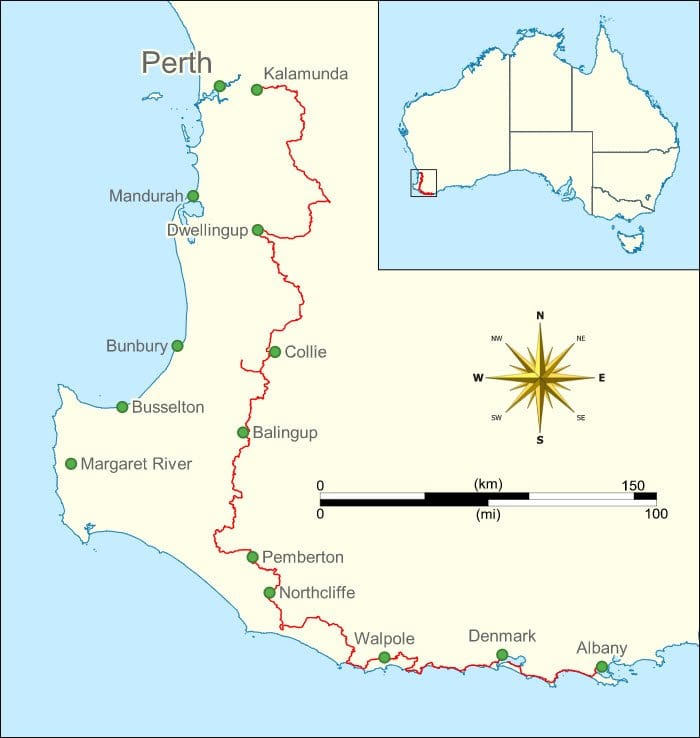
Bibbulmun Track route in the south west of Western Australia
Locally, I frequently hear of foiled adventures on the Bibbulmun Track. This is a 1,000km trail that extends from Kalamunda in the Perth hills, to Albany on the south coast. A lot of people start at the southern Albany end, so they can finish in Perth, or because that’s the recommended direction for Autumn travellers. The section from Denmark to Walpole (85km to 211km from the start) sees large sections of the trail underwater. Wading knee deep is not unusual, for hours on end, day after day. Complete footwear (shoe + sock) immersion scenarios are what can bring people undone before they’ve really even begun. I’ve heard from hikers and runners who have been forced to pull out and either rent accommodation for a week while their skin dries out, or abandon their plans altogether. It’s devastating! Macerated feet from immersion situations like this are impossible to sleep off overnight and carry on with, only to become further waterlogged the next day - even if the shoes were able to fully dry out overnight, which they won’t have. Dry socks don’t remain dry for long when you’re putting them back into wet shoes with wet padded insoles. And nor will your feet. Here's an anecdote from Katherine who did the Bibb Track end-to-end in 2022. Starting from Albany, she ran into trouble early on:
A mid-winter End2End of the 1000km Bibbulmun Track was always going to be soggy, especially in my preferred footwear, trail-runners. However I was barely 90km in, when foot masceration threatened everything. I'd hiked the Bibb before, but not in such unrelenting weather. In places, the track had became a running creek. My feet were necessarily in sopping shoes for hours at a time. The skin turned white and wrinkly, then began to shed in alarmingly thick sheets. It wasn't painful, but definitely confronting. I knew that the freshly exposed layers would be vulnerable to blistering and fungal infection. Since my hike was in peril, I cheekily made direct phone contact with podiatrist Rebecca Rushton. Her online Blister Prevention course, and products, had served me well for previous thru-hikes, and if ANYONE could solve my problem, it would be her. Indeed, she offered excellent advice, and I arrived at Kalamunda five weeks later with happy feet.
Are Waterproof Shoes the Answer?
Waterproof shoes might help if you were just walking through wet grasses and splashing through small puddles. But they won’t help if the shoe and sock is completely submerged. Water can still enter the shoe through the eyelets and along the tongue, not to mention the top where your foot enters the shoe. Gaiters won’t stop it either, not in full immersion situations. But do read these articles on hiking and running gaiters and full shoe ultramarathon gaiters.Are Waterproof Socks the Answer?
The only thing that will stop the water getting in contact with your skin is waterproof socks. But even then, there’s a slight catch. SealSkinz and Dexshell are the two main waterproof sock brands. Really, SealSkinz is the most readily available. Here are some links to check them and others out:- SealSkinz Waterproof Socks
- DexShell Waterproof Socks
- Showers Pass
- RandySun
- ArcticDry
- Team Australia
- And a few brands that don't seem to have websites, including Layeba, SuMade, Tanzant and Meikan
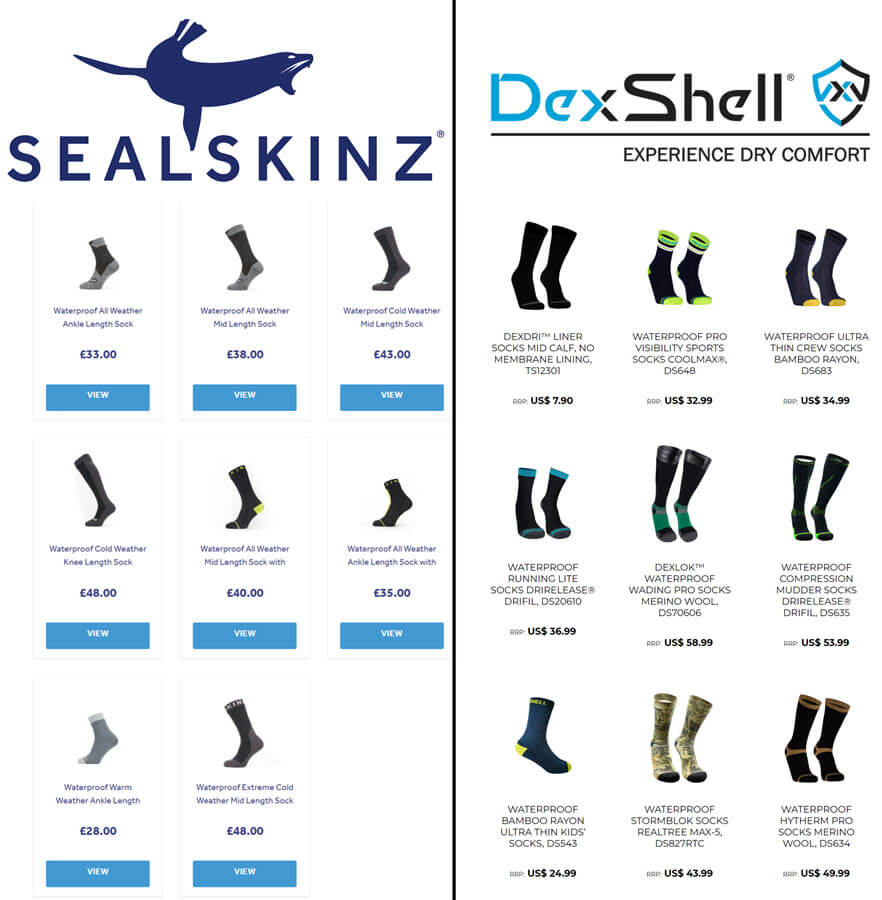
Waterproof sock ranges from SealSkinz and DexShell
I crudely tested the waterproofness of two socks from each brand a few years ago in my preventing maceration article. Using the water balloon test, I found that indeed, both socks are completely waterproof, except for the cuff. This is something you need to be aware of in immersion scenarios. Water can enter the sock at the cuff. To combat this, you can either purchase a sock like the DexShell knee high socks for that are suitable for wading, called DEXLOK™ Waterproof Wading Pro Socks. Or get the one of the others and gaffa tape the top of the sock to your leg. It seems a bit of an extreme measure, but if water makes it way in and you leave it in there, that’s a waterlogging environment you’re setting up there.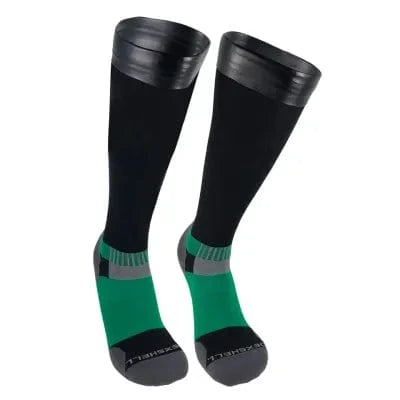
DEXLOK™ Waterproof Wading Pro Socks
The Downside of Waterproof Socks
Keeping water out generally means keeping water in. Assuming you keep 100% of environmental water out of your sock, your skin still has to deal with the ever-present moisture source of perspiration. Sure, the socks may say they are water vapour permeable or “breathable”. But if the situation on the outside of the sock is one of saturation, it’s unlikely the gradient will be favourable to the passive movement of water vapour.1) Probably Traps Moisture In
So, depending on how sweaty your feet are in general, or how hot and humid the environmental conditions are and how vigorous your exertion is, you may get a degree of maceration with waterproof socks just from perspiration. However, as discussed in the maceration prevention article, there’s a suggestion that external water is more damaging than internal sources.2) Might Make Feet Hot
Some people have reported they make their feet hotter, which makes sense. Comfort is important when your running or walking hour after hour, day after day. So I understand it would be difficult to weigh up whether to got with waterproof socks or not. One thing is for certain though - macerated feet aren’t just uncomfortable, they are DNF-worthy. If it were me, I would be milking the benefit of waterproof socks for as long as I possibly could before conceding defeat and letting my feet become saturated. Even then, as soon as I felt my feet had had a break from them, I’d get back into them if I was still wading through water.3) Extra Thickness
Waterproof socks are also quite thick. This can be problematic for feet that swell or where the shoes don’t have a lot of excess volume to spare. Not just discomfort but blisters can be the result. Blisters are no fun, and infected blisters are a real risk if you’re wading through the still water in puddles, but even though creeks and rivers. Blisters plus maceration would be an absolute nightmare situation. So if you suspect your event’s terrain and climate is going to demand waterproof socks, prioritise finding shoes that will accommodate them!4) Constrictive
On my advice, Katherine organised to get some waterproof socks sent down to her. However, she found them constrictive for her broad feet. She said:My daughter posted two pairs to a town I was to intersect in a week. Meanwhile, I used plastic bags between my socks and shoes. As it turned out, waterproof socks didn't really work for me as I need toe-socks (Injinjis). Also, they were too narrow for my wide feet; though theoretically being the correct size, waterproof socks are less stretchy.
Field Testing Waterproof Socks
No need to reinvent the wheel. Plenty of hikers and runners have road-tested SealSkinz, DexShell and other brands of socks. Take a look at:- Bike Hike Safari
- Mountain IQ
- The Nature Seeker
- Bushwalk Australia
- Runner's World
- Fiona Outdoors
- Fellrunner
Keeping Your Feet Warm: Heated Socks
There are other advantages to keeping your feet dry - it prevents them from getting quite so cold, and helps them warm up quicker. However, if you suffer from cold feet, chilblains and the like, your feet might need a little help to get warm and stay cozy warm. This is where heated socks come in. There is additional weight and bulk to carry becasue of the battery pack, but they are definitely worth a look if your painfully cold feet, and hands for that matter, are stopping you from hiking or camping out in cold environments. Heated socks could be a valuable addition to your gear collection. To explore your options for heated socks, gloves and mittens, check out Oz Backcountry, they have a great collection.
Conclusion
In endurance walking and running situations, waterproof socks definitely have their place, in certain situations. In fact, I think they can be absolutely indispensable! But as with everything, be realistic with your expectations. Have you used waterproof socks? What brand and style? How did they go in terms of:- keeping water out?
- trapping sweat in?
- making feet hot?
- making shoes too tight?
- where did you use them?
- what was the race or event?
- what were the climactic conditions?
